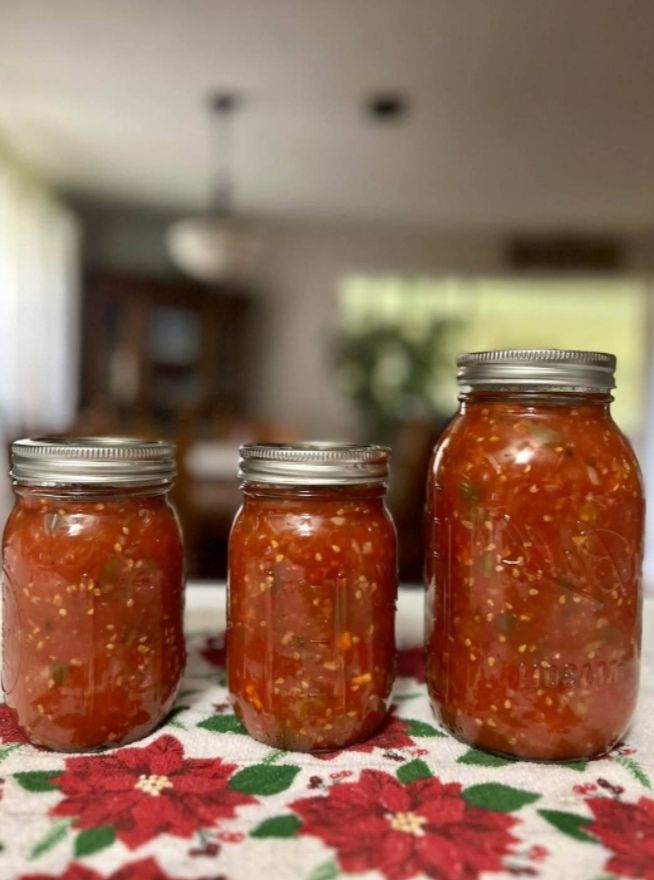Instructions
Prepare the Vegetables:
Wash all produce thoroughly. Core and dice the tomatoes into small chunks, catching as much juice as possible. Finely dice the onions and bell peppers into uniform pieces. For the jalapeños, remove seeds for milder heat or leave some seeds in for extra spice. Mince the garlic and roughly chop the cilantro.
Combine Ingredients:
In a large, non-reactive pot or bowl, combine the diced tomatoes with their juices, onions, bell peppers, jalapeños, and garlic. Stir in the chopped cilantro, lime juice, and vinegar. Add salt, cumin, black pepper, and sugar if using.
Mix and Marinate:
Stir all ingredients together thoroughly, ensuring the seasonings are evenly distributed. Let the mixture sit at room temperature for 15-20 minutes to allow the flavors to meld. Taste and adjust seasonings as needed – add more salt for depth, lime juice for brightness, or jalapeños for heat.
For Fresh Salsa (Refrigerator Storage):
Transfer the salsa to clean mason jars or airtight containers, leaving about an inch of headspace. Refrigerate for at least 2 hours before serving for best flavor development. Fresh salsa will keep in the refrigerator for up to 10 days.
For Canned Salsa (Long-Term Storage):
If you plan to can your salsa for shelf-stable storage, bring the mixture to a boil in a large pot. Reduce heat and simmer for 10 minutes, stirring occasionally. Ladle the hot salsa into sterilized mason jars, leaving 1/2 inch headspace. Wipe rims clean, place lids and rings, and process in a boiling water bath for 15 minutes for pints or 20 minutes for quarts. Adjust processing time if you’re at high altitude.
Tips for Perfect Salsa
Tomato Selection: Use ripe but firm tomatoes for the best texture. Roma or plum tomatoes work exceptionally well as they’re meatier with fewer seeds. Heirloom tomatoes add complex flavor but will create a thinner salsa.
Heat Level Control: The heat in jalapeños varies significantly. Always start with less and add more after tasting. Remove all seeds and membranes for mild salsa, leave some seeds for medium heat, or include everything for fiery salsa. Serrano peppers can be substituted for extra heat.
Consistency Matters: For chunkier salsa, hand-dice everything and avoid over-mixing. For a smoother, blended salsa, pulse half the mixture in a food processor before combining with the chunky portion.
Flavor Enhancement: Roasting the tomatoes, peppers, and onions before adding them creates a deeper, smokier flavor profile. Simply char them under the broiler or on a grill until blackened in spots.
Serving and Storage
This salsa is incredibly versatile beyond just chips and dip. Use it as a topping for grilled fish or chicken, stir it into scrambled eggs or omelets, layer it in quesadillas, or use it as a base for Mexican-inspired soups and stews. It adds instant flavor to burrito bowls, nachos, and taco salads.
When properly canned using the water bath method, this salsa will maintain quality for up to 12-18 months stored in a cool, dark place. Always check seals before storing and refrigerate after opening. Consume refrigerated opened jars within two weeks.
Customization Ideas
Add diced mango or pineapple for a tropical twist, incorporate roasted corn for Southwest flair, or mix in black beans for a heartier version. Fresh oregano, chipotle peppers in adobo, or a splash of tequila can add unique flavor dimensions.
Yield: About 3 quarts | Prep Time: 30 minutes | Cook Time: 10 minutes (if canning) | Total Time: 40 minutes
